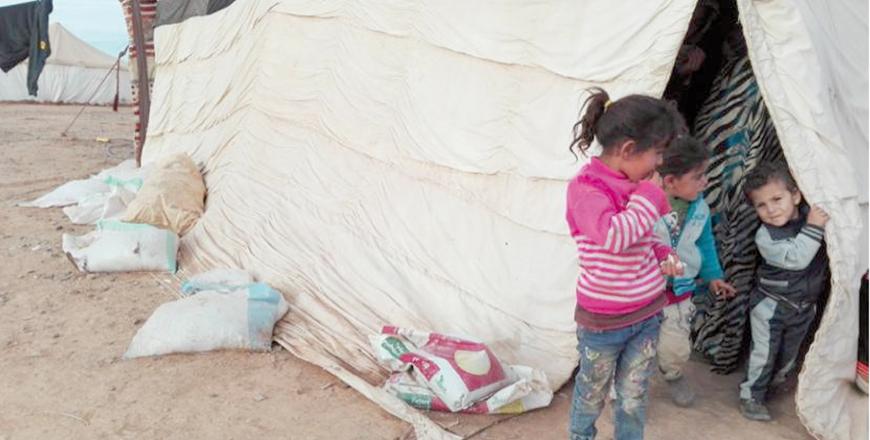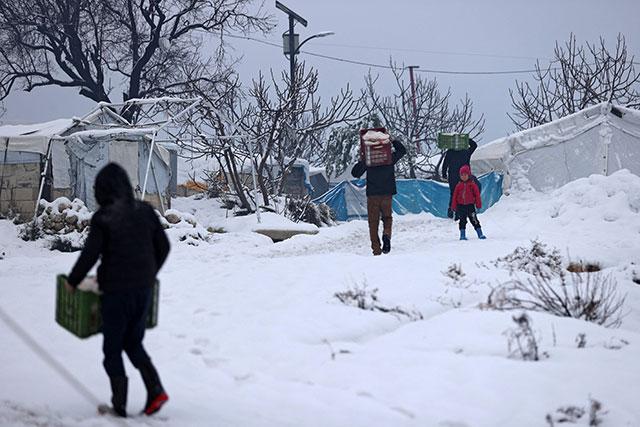You are here
Displaced Syrians at great risk as winter storms hit region, CARE warns
By JT - Jan 18,2022 - Last updated at Jan 18,2022

Most displaced people have found shelter in tents, unfinished buildings, and sheds, leaving them particularly vulnerable to harsh winter conditions, according to CARE International (Photo courtesy of CARE International)
AMMAN — Syrians, fleeing over a decade of war in their homeland, have found their situation exacerbated following the onslaught of heavy winter storms, according to a CARE International statement
In Jordan, Lebanon, and Syria, temperatures are expected to drop lower than they have in 40 years, reaching -14°C and lower, the statement from the international humanitarian organisation said.
Strong winds reaching up to 80km/h, coupled with heavy hail and snow in mountainous areas are endangering the lives of millions of people living in already precarious circumstances.
“This is yet another blow to people whose lives are already beyond unbearable. People can see their own breath when lying on their thin mattresses; you will see children walk around in flipflops and ripped shirts. Families are afraid that they will freeze to death,” said Jolien Veldwijk, CARE Syria country director, in the statement.
In Syria, over 6.7 million people have been internally displaced, while another 6.8 million live as refugees in neighbouring countries such as Jordan, Lebanon and Turkey.
Most displaced people have found shelter in tents, unfinished buildings, and sheds, leaving them particularly vulnerable to harsh winter conditions.
“With extremely low temperatures in Jordan at the moment and the long-term impact of the COVID-19 pandemic, winter assistance is more crucial than ever to help the most vulnerable refugees keep a roof over their heads and their families safe from the cold,” said Ammar Abu Zayyad, CARE Jordan country director, in the statement.
In Lebanon, refugees live across hundreds of informal settlements, lacking adequate protection.
“People don’t have jobs or incomes, no access to jobs. They are already suffering consequences of an unprecedented economic crisis in Lebanon and have no means to protect themselves against the expected snowstorms,” said Bujar Hoxha, CARE Lebanon country director, in the statement.
“CARE is particularly concerned about the situation of displaced people inside Syria, especially women and children. Deteriorating shelter conditions, limited fuel supply, and the use of hazardous materials to stay warm, are giving rise to grave health and environmental impacts. During the cold winter, mothers are usually the last ones to eat, and children are usually the first ones to freeze,” said Sherine Ibrahim, CARE Turkey’s country director, in the statement.
CARE’s teams across the region have been able to help many with winterisation support, including more than 86,000 people in Syria and 4,000 people in Jordan.
Across Syria and the region, CARE is supporting displaced people with insulating their tents, strengthening makeshift shelters, and distributing warm clothing, blankets, and cash. Cash is particularly important for people living in informal tent settlements to afford fuel for heating, as they are most affected by the cold.
“This crisis response remains severely underfunded. This year, we’ve only received a fraction of the funding needed to prepare people for the winter and protect them against the cold. Only 46 per cent of the funding needed to support Syrians is currently available,” Veldwijk said.
“The conflict in Syria has been ongoing for almost 11 years, and we are afraid donors are growing tired of funding humanitarian assistance. Unfortunately, the needs have only increased over the past years, and right now we can see people fearing to freeze to death because desperately needed funding is unavailable,” Veldwijk added.
While snowfall and sub-zero temperatures are not unusual in the Middle East, climate change has caused increased flooding and rainfall. “Flashfloods are simply washing away the tents and the few belongings people were able to take when their houses were bombed. The winters are getting harsher and deadlier, while families are less and less able to cope with freezing temperatures,” Veldwijik said.
Related Articles
AIN ISSA, Syria — Khadija Alloush made it out alive from Syria's battle-ravaged Raqqa with her five children, but she lost her seven-year-ol
OCUPIED JERUSALEM — Snow carpeted Jerusalem and the eastern Mediterranean on Thursday as a rare storm turned the holy city into a winter won
HARANBUSH, Syria — Two Syrian infant girls have died from harsh winter weather in northwest Syria where snow and rain have destroyed the ten














